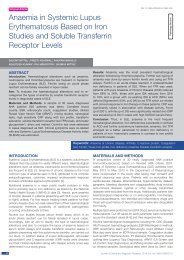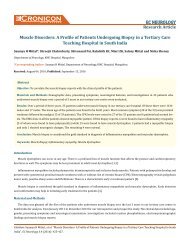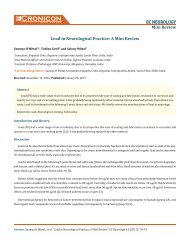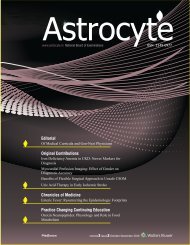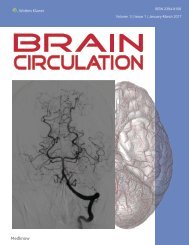Abnormal Levels of Consciousness and their Electroencephalogram Correlation- A Review
Create successful ePaper yourself
Turn your PDF publications into a flip-book with our unique Google optimized e-Paper software.
<strong>Abnormal</strong> <strong>Levels</strong> <strong>of</strong> <strong>Consciousness</strong> <strong>and</strong> <strong>their</strong> <strong>Electroencephalogram</strong> <strong>Correlation</strong>: A <strong>Review</strong><br />
There may be sharp <strong>and</strong> slow waves. Background, normal initially, shows delta <strong>and</strong> theta waves as disease progresses. Alcohol dementias<br />
<strong>of</strong>ten show normal EEG patterns. Specific changes may vary with the type <strong>of</strong> dementia. Newer techniques like coherence analysis, evoked<br />
potentials, <strong>and</strong> event related potentials are bound to add to sensitivity <strong>of</strong> the EEG [3,26].<br />
Conclusion<br />
EEG is a valuable tool in cases <strong>of</strong> abnormal levels <strong>of</strong> consciousness. And every EEG should be compared with prior EEGs to make out<br />
subtle changes. In expert h<strong>and</strong>s, it is a useful tool.<br />
Bibliography<br />
1. Posner JB <strong>and</strong> Plum F. “The toxic effects <strong>of</strong> carbon dioxide <strong>and</strong> acetazolamide in hepatic encephalopathy”. Journal <strong>of</strong> Clinical Investigation<br />
39.8 (1960): 1246-1258.<br />
2. Shimojyo S., et al. “Cerebral blood flow <strong>and</strong> metabolism in the Wernicke-Korsak<strong>of</strong>f syndrome”. Journal <strong>of</strong> Clinical Investigation 46.5<br />
(1967): 849-854.<br />
3. Kiloh l G. “The electroencephalogram in psychiatry”. Postgraduate Medical Journal 39 (1963): 34-47.<br />
4. Tamara G Fong., et al. “The interface between delirium <strong>and</strong> dementia in elderly adults”. Lancet Neurology 14.8 (2015): 823-832.<br />
5. Van der Kooi AW., et al. “Delirium detection using EEG: what <strong>and</strong> how to measure”. Chest 147.1 (2015): 94-101.<br />
6. Brenner RP. “The interpretation <strong>of</strong> the EEG in stupor <strong>and</strong> coma”. Neurologist 11.5 (2005): 271-284.<br />
7. Andrade Chittaranjan <strong>and</strong> Kumar Sanjay N. “Manic stupor”. Indian Journal <strong>of</strong> Psychiatry 43.3 (2001): 285-286.<br />
8. Raoul Sutter <strong>and</strong> Peter W Kaplan. “Electroencephalographic Patterns in Coma: When Things Slow down”. Epileptologie 29 (2012):<br />
201-209.<br />
9. Jacome De <strong>and</strong> Morilla-Pastor D. “Unreactive eeg: pattern in locked-in syndrome”. Clinical Electroencephalography 21.1 (1990): 31-<br />
36.<br />
10. C H Hawkes <strong>and</strong> l Bryan-Smyth. “The electroencephalogram in the “locked‐in” syndrome”. Neurology 24.11 (1974): 1015-1018.<br />
11. Patterson J R <strong>and</strong> Grabois M. “Locked-in syndrome: a review <strong>of</strong> 139 cases”. Stroke 17.4 (1986): 758-764.<br />
12. Billiard M <strong>and</strong> Dauvilliers Y. “Idiopathic hypersomnia”. Sleep Medicine <strong>Review</strong>s 5.5 (2001): 349-358.<br />
13. Yves Dauvilliers <strong>and</strong> Alain Buguet. “Hypersomnia”. Dialogues in Clinical Neuroscience 7.4 (2005): 347-356.<br />
14. Jocelyn Y Cheng., et al. “Nocturnal Frontal Lobe Epilepsy Presenting as Excessive Daytime Sleepiness”. Journal <strong>of</strong> Family Medicine <strong>and</strong><br />
Primary Care 2.1 (2013): 101-103.<br />
15. Tarik Al-ani., et al. “On-linear EEG Analysis <strong>of</strong> Idiopathic Hypersomnia”. Imaging <strong>and</strong> Signal Processing 6134 (2010): 297-306.<br />
16. Ganji Srinivas S., et al. “Hypersomnia Associated with a Focal Pontine Lesion”. Clinical EEG <strong>and</strong> Neuroscience 27.1 (1996): 52-56.<br />
17. SM Hastak., et al. “Abulia: No Will, No Way”. Journal <strong>of</strong> the Association <strong>of</strong> Physicians <strong>of</strong> India 53 (2005): 814-818.<br />
34<br />
Citation: Saumya H Mittal., et al. “<strong>Abnormal</strong> <strong>Levels</strong> <strong>of</strong> <strong>Consciousness</strong> <strong>and</strong> <strong>their</strong> <strong>Electroencephalogram</strong> <strong>Correlation</strong>: A <strong>Review</strong>”. EC<br />
Neurology 4.1 (2016): 30-35.




